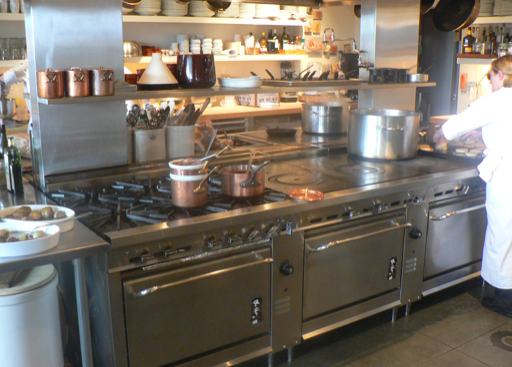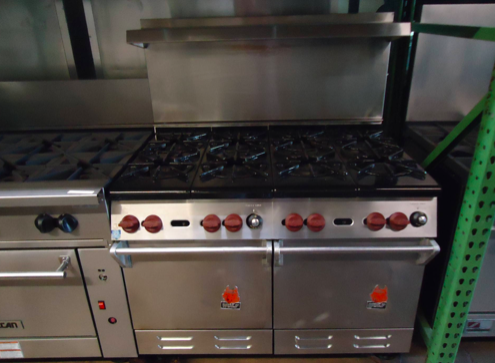Commercial gas, electric, and convection ranges are an important part of just about any commercial kitchen. As a result there’s often an abundance of high-quality used equipment on the market for much less than you would pay to buy new. Click our listings below to see detailed descriptions, photos, price and location for each unit. Click here to see our full inventory of used restaurant equipment.
[display_listings l_type=”94″]
Introduction

At the center of every commercial kitchen, whether you’re cooking in a busy urban restaurant or the back of a country store in the middle of nowhere, in a bustling hospital cafeteria, or in a cramped food truck, sits the commercial range.
Whether gas, electric, or convection, the commercial range represents the heartbeat of every kitchen across the country; without a range, a kitchen would never be able to fry, grill, broil, saute, boil, braise, simmer, warm, and bake all of those raw ingredients into delectable culinary masterpieces, waiting to be gobbled up by hordes of hungry customers.
Whether you’re starting from scratch and building a new commercial kitchen from the ground up, replacing a hard-working unit that’s finally gone belly-up after years of dedicated service, or adding additional ranges across multiple cooking stations to increase efficiency in the kitchen, choosing the right range can be one of the most important equipment purchasing decisions you can make.
There are two basic types of ranges designed for commercial use: Restaurant Ranges and Heavy Duty Ranges, which are sometimes also referred to as “modular” or “master series” ranges. In general, the restaurant range is the most common type of range typically found in commercial kitchens; these standalone ranges are designed to be easy-to-use, deliver high-BTU output for heating pans quickly and searing food efficiently, and are manufactured to stand up to the rigors of commercial cooking.
Heavy duty ranges typically offer additional options, and are designed to be used in tandem with additional ranges for high-production kitchens. They are built with even more durable materials, heavy gauge steels, more welded joints, and feature an even higher BTU output for the busiest kitchens. Of course, as a result, these types of ranges are typically more expensive than their standalone counterparts.
In addition to these two basic types of commercial ranges, chefs and owners also need to make the decision between propane and natural gas, or electric-fired ranges. Several factors can help drive this decision: Personal preference, the availability of gas and electric connections, how much “firepower” you need, and your budget are all important factors to consider when choosing a heating technology.
Electric ranges are usually cheaper, easier to install, and don’t require a gas line for operation. Electric ranges use metal elements containing resistance wires, covered by protective hot tops or French plates. Though gas ranges tend to be the more popular choice among professional chefs, advancements in induction technology (which don’t heat up the kitchen and in some cases, may even be installed without an exhaust hood or fire suppression system) have been increasing the popularity of these types of ovens in recent years.
Gas ranges have open burners which range from 25,000 to 260,000 BTUs, and dials that allow for instant ignition (which creates immediate heat and quicker cooking times) and precise, consistent temperature control. In addition, natural gas and liquid propane tend to heat more efficiently, which usually translates to reduced cost to run the range. Some of these savings may be offset by the relatively high cost to install in kitchens without existing gas lines, however.
Choosing the Range Size and Number of Burners That’s Right for You

When it comes to selecting the right size range to suit your particular kitchen, bigger isn’t always better (and can certainly be cost prohibitive). The most common widths are 24″, 48″, and 60″, but models are available anywhere from 12″ up to 72″.
When determining how much range you can use, first consider the size of your exhaust hood. Most state regulations require your hood to extend at least 6″ beyond the width of your appliances, so if your hood is 48″ wide, the biggest possible range you should consider would be 36″. When in doubt, check with your city’s code enforcement office or state fire marshall, to be sure.
In addition to the physical limitations of your commercial space, it’s also worth considering how you plan to use your range. For example, if you’re cooking lots of burgers or pancakes, do you need burners at all, or would you be better off with a flat top?
Think about how many burners you will regularly use at any given moment, and make an effort to balance the number of burners with the available grill space. While 6 or 10 burner configurations are the most common, you can find grills with almost any number of burners, to suit your needs.
How Do You Evaluate a Used Gas, Electric, or Convection Range?

Buying a gas, electric, or convection range used instead of new is a great place to start cutting costs in your equipment-buying needs for your commercial kitchen. However, because most commercial ranges tend to run all day, whether you’re looking at a used model that was used in a large university cafeteria, the dining room of a busy hotel, or a small mom-and-pop operation.
If a used commercial range has been neglected or improperly maintained, it can cause problems with food quality and increase waste. Or even worse, it can cause your entire building to burn to the ground. While buying a used range is a good option for most owners, the wear and tear on these units can be intense, which makes careful evaluation important.
Of course, when buying a used commercial range, you do run the risk of experiencing a breakdown or needing maintenance sooner than with a new model. Newer ranges tend to have more technologically advanced features which may be convenient, but which also makes them more prone to breakdown.
In general, gas ranges operate more reliably for year after year, with less technology that’s prone to breakdown, versus electric ranges. Begin by ensuring that all burners ignite instantly (for gas models) and that the burners don’t take too long to heat (for electric models).
Gas ranges should have no leaks anywhere in the gas lines, for obvious reasons. Find out how long the range was in service, and what kinds of repairs or maintenance were performed. Check that all dials are functioning properly, and that igniters all all sparking as they should.
Check for obvious signs of neglect or misuse, such as rust or corrosion or missing parts. Finally, when it comes to aesthetics, remember: A used commercial gas, electric, or convection range that looks like a mess, but which provides quick, consistent, even heat is preferable to a shiny, cosmetically perfect range with all of the bells and whistles, but which heats slowly or unevenly.
If something doesn’t seem to be working right with the used electric, gas, or convection range you are considering, or if there are known problems with the unit, contact the manufacturer prior to closing the deal to check on the replacement price of parts that are prone to failure.
You may be able to negotiate an amazing price on an oven that the current owner thinks of as “broken,” if you’re willing to have it repaired yourself inexpensively. Finally, don’t get hung up on things like “cleanliness,” when it comes to evaluating a used commercial range for potential purchase.
You’d be amazed at the work commercial cleaning products and degreasers can do to salvage a used commercial range that looks like it’s destined for the scrap heap. If the model you’re looking at seems particularly funky, try to use this a negotiating point to score a lower price; a few hours of elbow grease is well worth the tradeoff, if it means landing an expensive commercial range for a few hundred dollars less.
